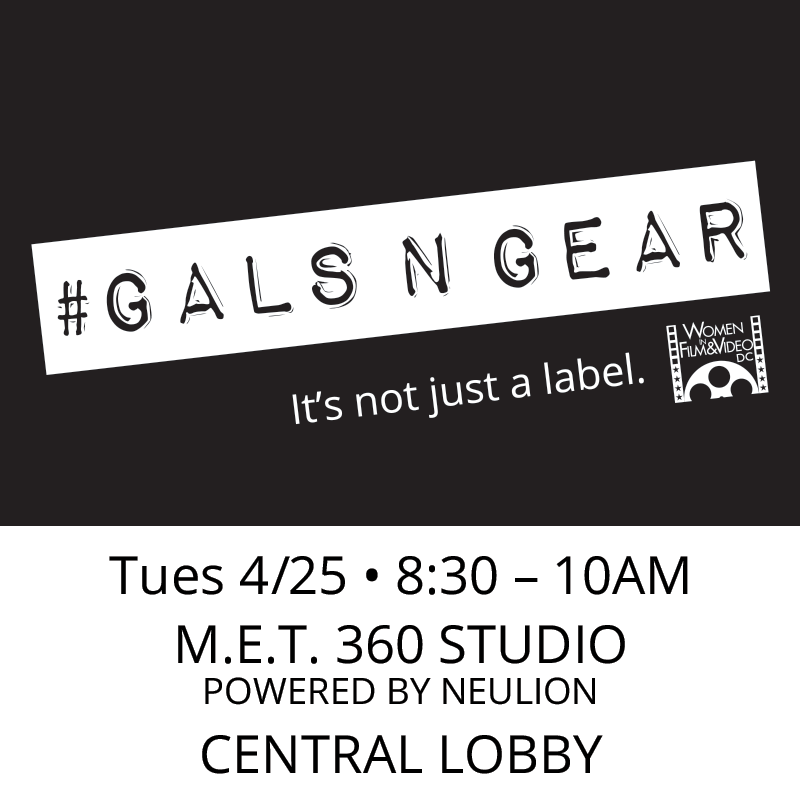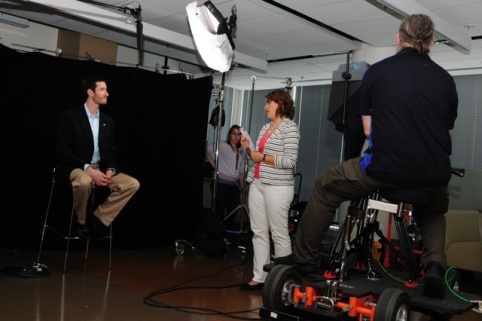 This week I produced and directed a fun shoot for an international education association. What might appear at first glance to be a simple studio shoot was really a multi-tasking day that allowed us to gather multiple content streams at once, for later multi-purposing. Here are some of the elements we shot in less than 8 hours:
This week I produced and directed a fun shoot for an international education association. What might appear at first glance to be a simple studio shoot was really a multi-tasking day that allowed us to gather multiple content streams at once, for later multi-purposing. Here are some of the elements we shot in less than 8 hours:
-5 interviews with a Canon 300 Mark II camera
-Secondary/side angle of all interviews w/a Canon DSLR camera on a slider
-6 direct-to-camera reads of a brief :30 appeal
-BTS (behind the scenes) video and photos
-Samsung Gear VR footage of our setup
-Hyperlapse time lapse footage of our setup
-Smart phone photos and videos of our day on the set
And now here are all the outputs we can achieve for this client:
-A short video about the association for their website combining the interviews, BTS footage, and other existing content from the association
-Social media sharing content using the BTS photo and smart phone content
-A Facebook video campaign using the direct-to-camera content
-An Instagram video campaign using the direct-to-camera content
-Interview transcripts that can be mined for quotes for website and newsletter sharing
-VR and timelapse content that can boost social sharing

Planning For Multiple Content Streams
Of course, this all takes advanced planning. You can’t accomplish multiple outputs without having the right people on your production team. You need to have a designated BTS Photographer and ideally a separate BTS Videographer. These roles are different, but can sometimes be combined as long as you are clear about what you need from each format. You will also need a DIT–Digital Information Tech–who can be offloading, ingesting and verifying your footage and photo media cards as you go, because you will need to keep using cards throughout the day. That person will also be meta-tagging your shots so you can find what you need for quick turnarounds later. Again, this person could have another role such as production assistant, but you had better be darn sure they really know what they are doing when it comes to media management. On some shoots I rely on my director of photography (camera op) to do this job, but then you have to wait until the end of the day. This means you need to purchase more media cards up front, since you won’t want to “blow them away” until you have ingested, duplicated, and verified all your footage. For a multi-camera shoot like the one we did this week, I did not want to distract my camera guy with that task, so we had our BTS photographer do it because she is also quite experienced at this DIT role. She also pulled up all our footage in a laptop version of Premiere Pro, our NLE (nonlinear editing) platform, so that we could check our colors “in the real world”.
Designing Your Workflow for Spoken Word Content
You’ll also need a workflow plan for your Transcripts. I like to use a real, human transcriber for long interviews or anything involving speakers with accents. The folks at Noble Transcription do a great job. If you live in a town with lawyers, you can find a transcription service! For quick interviews, Speechmatics is an AI platform that does a pretty nifty job. You might have to correct things like acronyms, which it isn’t good at recognizing. I then import my transcripts into PremierePro using Transcriptives, a new plug-in from Digital Anarchy. Transcriptives attaches speech elements to every clip from the interview, allowing you to build your script, output drafts that everyone can review on paper, and output your final captioning.
Archiving and Future-Proofing
Really, the future-proofing comes in the planning stage. I like to shoot everything in 4K these days. That gives me enough lattitude to compress content for small screen delivery without compromising quality. It also allows me to crop images to 2K, giving me the ability to add a second “angle” without moving my camera. It also gives me enough color space and pixels to crop unusual specs like the awful Facebook vertical, while keeping high quality color and resolution for larger-screen delivery. Future-proofing also means ensuring that you have permissions “in any and all media” from all your participants, so you don’t have to go back to them every time you change your output. You also will need to get the right licenses for any music or stock images you add into your final products. As far as archiving goes, we really don’t know what the next digital medium will be, so the best policy is to save all your content in its highest quality form, without any added text or soundtracks. This will allow you to continue multi-purposing well into the future.
I’ll have a new LinkedIn Learning course on this subject soon, so watch this space for updates!



 4. Have an Evening Food Strategy – Are you sensing a theme here? Since I’m feeding myself on my own dime during NABShow, I try to skip the overpriced strip restaurants for many meals. These are some of my all time favorites as well as places I still want to explore. Let me know if you want to grab a bite!
4. Have an Evening Food Strategy – Are you sensing a theme here? Since I’m feeding myself on my own dime during NABShow, I try to skip the overpriced strip restaurants for many meals. These are some of my all time favorites as well as places I still want to explore. Let me know if you want to grab a bite!
 nds of dollars worth of cool stuff! We want to be sure these professionals get the limelight they deserve, and inspire the next generation of women working behind the lens in our industry.
nds of dollars worth of cool stuff! We want to be sure these professionals get the limelight they deserve, and inspire the next generation of women working behind the lens in our industry.
 So-called “real people” can add power to a video story. For testimonials, someone who actually uses the product can be compelling. If the story focuses on a charity, someone who has lived the day-to-day impact can help raise funds more effectively than an on-camera professional host. A person who works in an organization might be the very best at explaining a new process or tool.
So-called “real people” can add power to a video story. For testimonials, someone who actually uses the product can be compelling. If the story focuses on a charity, someone who has lived the day-to-day impact can help raise funds more effectively than an on-camera professional host. A person who works in an organization might be the very best at explaining a new process or tool. eelancers in the creative disciplines—graphic design, video, set design, etc.—we’ve got a lot on our plates. Every day we’ve got to be, well, creative out-of-the-box thinkers, able to leap small budgets in a single bound, staying on the bleeding edge of trends, and up on the latest hardware, software and teams that make it all possible. Plus we’ve got to run our businesses, paying our bills, invoicing our clients, and thinking strategically about our careers and where we want to go next. It’s a tall order. Here are some ways we can break it down and get it done.
eelancers in the creative disciplines—graphic design, video, set design, etc.—we’ve got a lot on our plates. Every day we’ve got to be, well, creative out-of-the-box thinkers, able to leap small budgets in a single bound, staying on the bleeding edge of trends, and up on the latest hardware, software and teams that make it all possible. Plus we’ve got to run our businesses, paying our bills, invoicing our clients, and thinking strategically about our careers and where we want to go next. It’s a tall order. Here are some ways we can break it down and get it done.



